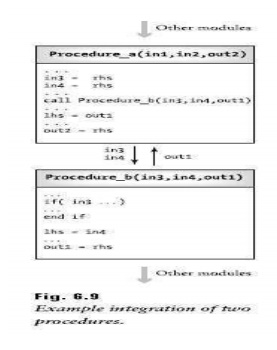Chapter: Software Testing : Levels of Testing
Designing integration tests
Designing integration tests
Integration
tests for procedural software can be designed using a black or white box
approach. Both are recommended. Some unit tests can be reused. Since many
errors occur at module interfaces, test designers need to focus on exercising
all input/output parameter pairs, and all calling relationships. The tester
needs to insure the parameters are of the correct type and in the correct
order. The author has had the personal experience of spending many hours trying
to locate a fault that was due to an incorrect ordering of parameters in the
calling routine. The tester must also insure that once the parameters are
passed to a routine they are used correctly. For example, in Figure 6.9,
Procedure_b is being integrated with Procedure_a. Procedure_a calls Procedure_b
with two input parameters in3, in4. Procedure_b uses those parameters and then
returns a value for the output parameter out1. Terms such as lhs and rhs could be any variable or expression. The reader should
interpret the use of the variables in the broadest sense. The parameters could
be involved in a number of def and/or
use data flow patterns. The actual
usage patterns of the parameters must be checked at integration time. Data
flow-based (def-use paths) and control flow (branch coverage) test data
generation methods are useful here to insure that the

input
parameters, in3, in4, are used properly in Procedure_b. Again data flow methods
(def-use pairs) could also be used to check that the proper sequence of data
flow operations is being carried out to generate the correct value for out1
that flows back to Procedure_a.
Black box
tests are useful in this example for checking the behavior of the pair of
procedures. For this example test input values for the input parameters in1 and
in2 should be provided, and the outcome in out2 should be examined for
correctness. For conventional systems, input/output parameters and calling
relationships will appear in a structure chart built during detailed design.
Testers must insure that test cases are designed so that all modules in the
structure chart are called at least once, and all called modules are called by
every caller. The reader can visualize these as coverage criteria for
integration test. Coverage requirements for the internal logic of each of the
integrated units should be achieved during unit tests. Some black box tests
used for module integration may be reusable from unit testing. However, when
units are integrated and subsystems are to be tested as a whole, new tests will
have to be designed to cover their functionality and adherence to performance
and other requirements (see example above).
Sources
for development of black box or functional tests at the integration level are
the requirements documents and the user manual. Testers need to work with requirements
analysts to insure that the requirements are testable, accurate, and complete.
Black box tests should be developed to insure proper functionally and ability
to handle subsystem stress. For example, in a transaction-based subsystem the
testers want to determine the limits in number of transactions that can be
handled. The tester also wants to observe subsystem actions when excessive
amounts of transactions are generated. Performance issues such as the time
requirements for a transaction should also be subjected to test. These will be
repeated when the software is assembled as a whole and is undergoing system
test.
Integration
testing of clusters of classes also involves building test harnesses which in
this case are special classes of objects built especially for testing. Whereas
in class testing we evaluated intraclass method interactions, at the cluster
level we test interclass method interaction as well. We want to insure that
messages are being passed properly to interfacing objects, object state
transitions are correct when specific events occur, and that the clusters are
performing their required functions. Unlike procedural-oriented systems,
integration for object-oriented systems usually does not occur one unit at a
time. A group of cooperating classes is selected for test as a cluster. In
their object-oriented testing framework the method is the entity selected for
unit test. The methods and the classes they belong to are connected into
clusters of classes that are represented by a directed graph that has two
special types of entities.These are method-message paths, and atomic systems
functions that represent input port events. A method-message path is described
as a sequence of method executions linked by messages. An atomic system
function is an input port event (start event) followed by a set of method
messages paths and terminated by an output port event (system response).Murphy
et al. define clusters as classes that are closely coupled and work together to
provide a unified behavior [5]. Some examples of clusters are groups of classes
that produce a report, or monitor and control a device.Scenarios of operation
from the design document associated with a cluster are used to develop test
cases. Murphy and his co-authors have developed a tool that can be used for
class and cluster testing.
Related Topics